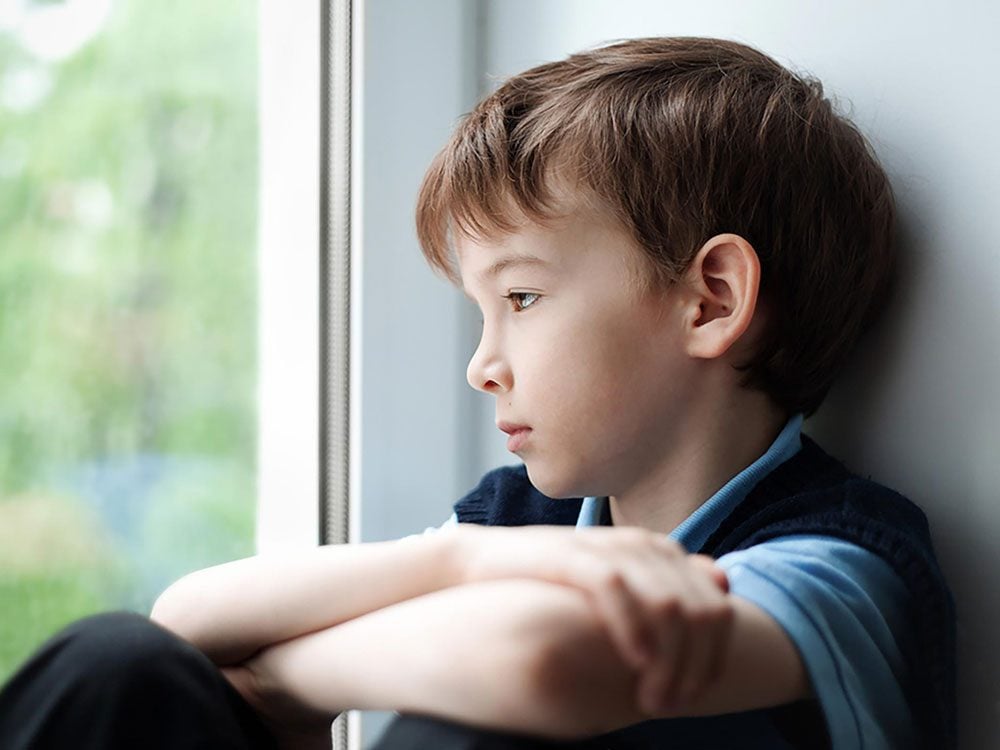
A few weeks ago, I went into my son Chase’s class for tutoring. I’d e-mailed Chase’s teacher one evening and said, “Chase keeps telling me that this stuff you’re sending home is math—but I’m not sure I believe him. Help, please.” She e-mailed right back and said, “No problem! I can tutor Chase after school anytime.” And I said, “No, not him. Me. He gets it. Help me.”
And that’s how I ended up standing at a chalkboard in an empty fifth-grade classroom while Chase’s teacher sat behind me, using a soothing voice to try to help me understand the “new way we teach long division.” Luckily for me, I didn’t have to unlearn much because I’d never really understood the “old way we taught long division.” It took me a solid hour to complete one problem, but I could tell that Chase’s teacher liked me anyway. She used to work with NASA, so obviously we have a whole lot in common.
Afterward, we sat for a few minutes and talked about teaching children and what a sacred trust and responsibility it is. We agreed that subjects like math and reading are not the most important things that are learned in a classroom. We talked about shaping little hearts to become contributors to a larger community—and we discussed our mutual dream that those communities might be made up of individuals who are kind and brave above all.
And then she told me this.
Every Friday afternoon, she asks her students to take out a piece of paper and write down the names of four children with whom they’d like to sit the following week. The children know that these requests may or may not be honoured. She also asks the students to nominate one student who they believe has been an exceptional classroom citizen that week. All ballots are privately submitted to her.
And every single Friday afternoon, after the students go home, she takes out those slips of paper, places them in front of her, and studies them. She looks for patterns.
Who is not getting requested by anyone else?
Who can’t think of anyone to request?
Who never gets noticed enough to be nominated?
Who had a million friends last week and none this week?
You see, Chase’s teacher is not looking for a new seating chart or “exceptional citizens.” Chase’s teacher is looking for lonely children. She’s looking for children who are struggling to connect with other children. She’s identifying the little ones who are falling through the cracks of the class’s social life. She is discovering whose gifts are going unnoticed by their peers. And she’s pinning down—right away—who’s being bullied and who is doing the bullying.
As a teacher, parent, and lover of all children, I think this is the most brilliant Love Ninja strategy I have ever encountered. It’s like taking an X-ray of a classroom to see beneath the surface of things and into the hearts of students. It is like mining for gold—the gold being those children who need a little help, who need adults to step in and teach them how to make friends, how to ask others to play, how to join a group, or how to share their gifts. And it’s a bully deterrent because every teacher knows that bullying usually happens outside her eyeshot and that often kids being bullied are too intimidated to share. But, as she said, the truth comes out on those safe, private, little sheets of paper.
As Chase’s teacher explained this simple, ingenious idea, I stared at her with my mouth hanging open. “How long have you been using this system?” I said.
Ever since Columbine, she said. Every single Friday afternoon since Columbine. Good Lord.
This brilliant woman watched Columbine knowing that all violence begins with disconnection. All outward violence begins as inner loneliness. She watched that tragedy knowing that children who aren’t being noticed may eventually resort to being noticed by any means necessary.
And so she decided to start fighting violence early and often in the world within her reach. What Chase’s teacher is doing when she sits in her empty classroom studying those lists written with shaky 11-year-old hands is saving lives. I am convinced of it.
And what this mathematician has learned while using this system is something she really already knew: that everything—even love, even belonging—has a pattern to it. She finds the patterns, and through those lists she breaks the codes of disconnection. Then she gets lonely kids the help they need. It’s math to her. It’s math.
All is love—even math. Amazing.
What a way to spend a life: looking for patterns of love and loneliness. Stepping in, every single day, and altering the trajectory of our world.
Glennon Doyle Melton writes the popular blog momastery.com and is the author of Carry On, Warrior: The Power of Embracing Your Messy, Beautiful Life.
Here’s how to stand up to bullies at work and at home.

Behold, the Incredible, Edible egg!
The egg white is a cholesterol-free source of animal protein, and the yolk is our most concentrated dietary source of choline, an uber-important nutrient that assists in brain development, helps you maintain focus, and improves memory. When eggs are also supplemented with docosahexaenoic acid (DHA) (an omega-3 fatty acid that serves as a structural component of the brain), they’re virtually unparalleled as a brain-superfood. (Here are more great brain foods to try.)
Due to allergy concerns, however, parents in this country are customarily advised to wait a full year before introducing their babies to eggs. That may soon change, thanks to a brand-new study out of Washington University in St. Louis, which showed that feeding eggs to babies as early as six months results in higher concentrations of brain-enhancing choline and DHA. The study, which was published in the American Journal of Clinical Nutrition, used data from another study by the same group of scientists that was published earlier in the year, which found that introducing eggs to babies at six months significantly improves growth in young children.
For both studies, a group of 163 babies, aged six to nine months, from a rural, indigenous population in Ecuador, were randomly assigned to be fed either one egg per day for six months (the “egg intervention group”) or no eggs at all (the “control group”). For the earlier-published research, the babies growth was measured. For this research, the babies’ blood was tested for levels of choline, DHA, and other vital nutrients. What the scientists found was that after six months, the egg intervention group had significantly higher concentrations of choline, DHA, and several other important nutrients in their bloodstream. And as an added bonus, there were no allergic reactions reported. (Here are three surprising lessons all grown-ups can learn from babies.)
“The findings supported our hypothesis that early introduction of eggs significantly improved choline and other markers in its methyl group metabolism pathway,” the study authors wrote. Since the early introduction of eggs—as early as six months—can benefit not only physical growth but also brain development, it may not be long before pediatricians begin recommending that parents introduce eggs as early as six months.
You need to add these five superfoods to your diet!

How Baby Food Makes the Perfect Margarita
A top-notch margarita should be just the right balance of sour and sweet with a hint of that signature tequila flavour. But there’s one ingredient that takes a margarita from perfectly tasty to perfectly tasty and unique, and you won’t find it in any liquor store: baby food. Yep, you read that right.
“Gerber makes really great fruit puree that’s good enough for our growing nation of children, so why not put it in a cocktail for a pure fruit flavour? There’s a whole rainbow of flavours for you to work with,” says master mixologist Brian Van Flandern of mymixologist.com, who was dubbed “America’s Top Mixologist” by Food Network. (Try one of these movie-inspired cocktails!)
It might sound strange, but Van Flandern is so confident in Gerber fruit’s alternative role as a cocktail star that he serves it up at the trendy The Garden Bar in the upscale hotel Montage Beverly Hills in California. Named the Georgie Gerber after chef Geoffrey Zakarian’s son, it’s a popular signature drink at the restaurant of the same name, Georgie. Add 1 ½ ounces blanco tequila, ½ ounce agave nectar, ½ ounce fresh squeezed lime juice, one ounce Gerber peach baby food, and one egg white to a cocktail shaker and shake vigorously; then add ice, shake again, and strain into a glass. “The egg whites give a little frothy texture and the combination is balanced and really tasty,” says Van Flandern.
As long as you use a good quality 100 per cent agave tequila (he suggests blanco before reposado or anejo, which are aged longer and tend to have a smokier flavour) and fresh squeezed lime juice (“Fresh is critical, no pre-made margarita mix!”), you can experiment with your favourite fruit purees like blueberry, pear, mango, or apple. For a mild smokiness that doesn’t overpower, try Santo Puro Mezquila, a blend of mezcal (also distilled from agave) and tequila.
“Always taste before serving. If it’s too sweet, add a little more lime juice; too sour, add a touch more fruit; not strong enough, pour another splash of tequila,” says Van Flandern. (We’ve rounded up 20 summer cocktail recipes that are perfect for sipping on the porch, patio or balcony.)
And if you just can’t seem to get the proportions right, there’s one more trick that might be the easiest yet: “Go to a good bar, and ask the bartender to make it right in front you. Take notes and enjoy!” he says. (If you happen to have a tad too many, don’t miss these tips on curing a hangover naturally.) Cheers!
I Don’t Want Anything for Valentine’s Day. Or Do I?
Please don’t get me anything for Valentine’s Day. I mean it. I don’t need anything. I don’t need you to give me material things to show me how much you love me. I know you love me. That’s all that matters!
I mean, OK, if you really want to do something to show me you love me this Valentine’s Day, you can just make me something. Handmade gifts are the best! I would love nothing more than a thoughtful handmade Tiffany diamond ring or card.
If you do make me a card, you don’t have to write a love poem in it or anything like that. I don’t need all that mushy stuff. Besides, not many words rhyme with my name, Robin. Bobbin? No, that’s not good for a poem. Maybe try love. Dove … glove … in awe of … I don’t want to put words in your mouth.
I for sure don’t need a pretty heart-shaped box of chocolates for Valentine’s Day. You never know what is inside each piece, so you have to take a little bite out of all of them just to find the one you like—which is all of them. But no, I can’t eat them anyway, because I’m trying to not eat sweets. Unless it’s a special occasion.
Some women like getting adorable red or pink teddy bears for Valentine’s Day. You know, the ones that have I Love You embroidered on them. But not me! I can’t even imagine where I would keep something like that, besides on my bed or on the couch or in the back window of my car or on my desk at work. Where would I put something like that?
I don’t need to go out for a fancy dinner on Valentine’s Day. Even if we wanted to get a table at a fancy restaurant for Valentine’s Day, we wouldn’t be able to now. It’s too late. Right? Are you sure? Maybe we should call around.
You did? Oh. Well, there’s no need to make a special romantic candlelit dinner for me at home. I don’t need a perfectly cooked filet mignon with mashed potatoes and asparagus—I’m fine with leftovers or frozen pizza. “No Fuss” is my middle name! For sure, don’t worry about making a delicious creamy cheesecake with cherry topping for dessert. Cheesecake is hard to make. (There are really easy recipes online.)
Oh, and definitely don’t get me red roses for Valentine’s Day. Yuck! Who would want red roses? Pink roses are prettier. But as I said, please don’t get them for me. They will just die anyway, and I would be able to really enjoy them for only a week or so—well, probably longer if I put an aspirin in the water. They would probably stay pretty for almost two weeks. Maybe three. But don’t get me any. I don’t need them.
And don’t even think about planning a surprise romantic Valentine’s weekend getaway. I don’t need to be whisked away for a fun trip to know that you love me. That would be just too much planning! How would I pack for a surprise trip? You would have to pack a suitcase for me, and then I would have to wear what you packed for me. Like a bikini.
Or my comfy flats that would make it easier to walk on the cobblestones in, say, Rome.
Or that blue sweater (in the third drawer on the right side of the dresser, beneath the gray shawl) to keep me warm during those chilly February nights in Paris.
But I know you, and I’m sure you are sensible and know a surprise romantic trip would not be something I would enjoy at all.
It’s a cruise, isn’t it? You booked us on a romantic cruise?
Discover the surprisingly dark history of Valentine’s Day!

Blood and Roses: The History of Valentine’s Day
Ah, Valentine’s Day. Such a glorious excuse to dwell on love and romance. But ironically, this day of roses, chocolates, and heart-shaped cards has a dark history. (Find out more Valentine’s Day facts that will truly surprise you.)
Valentine’s Day actually marks the date of the execution of St. Valentine by the Roman emperor Claudius II during the third century AD. And what was St. Valentine’s crime? The most popular theory holds that he’d been officiating at the weddings of soldiers, despite that marriage had been outlawed for them. Apparently, the emperor felt that love and romance made for weaker soldiers. (Make your sweetheart giggle on February 14 with these hilarious stories.)
Long before St. Valentine’s execution, February 14 had come to be associated with fertility—and blood. Between February 13 and 15, Romans celebrated the feast of Lupercalia by sacrificing a goat and a dog and then whipping naked women with the hides, all in the interest of making the women more fertile. In the fifth century AD, Pope Gelasius I outlawed Lupercalia and officially declared February 14 to be the feast of St. Valentine, or Valentine’s Day. (Check out the top 10 solo travel destinations for Valentine’s Day.)
As the years went on, Valentine’s Day may have become conflated with the Norman celebration of “Galatin’s Day,” according to NPR (Galatin referred to a “lover of women”). As such, by the time Geoffrey Chaucer wrote Parliament of Fowls, which referred to St. Valentine’s Day as the day when birds found their mates (late 14th century), St. Valentine’s Day had already entered the public consciousness as a day associated with love. By the late 16th century, William Shakespeare used a reference to St. Valentine’s Day to foreshadow Ophelia’s suicide in Hamlet.
Although Valentine’s Day continues to be associated with hearts and flowers, in the last century, it has also continued to be associated with blood spatter and murder. A few notable bloody Valentine’s Days include:
- The Valentine’s Day Massacre of 1929.
- The unsolved murder of young lovers Jesse McBane and Patricia Mann, which occurred on Valentine’s Day 1971.
- The unsolved murder of teens Nicholas Kunselman and Stephanie Hart (who were dating) on Valentine’ Day 2000.
- The murder by Oscar Pistorius of Reeva Steenkamp on Valentine’ Day 2013.
- The murder-suicide of an elderly couple in Alabama on Valentine’ Day 2015.
But hey, we don’t want to kill the mood—so please, instead of thinking about Valentine’s Day’s surprisingly dark history, consider these wonderful Valentine’s Day gifts you can get for your boo, or what you can do for yourself on Valentine’s Day if you’re single.

How to Squat Correctly
You may not realize it, but you squat almost every day. You may have done a squat when you went to grab something from the bottom drawer of your dresser or when you go to pick up your kid. But, doing a squat for the purpose of building muscle and control of your body is something that requires a little more thought. (These exercises can cut your risk of heart disease in half.)
Maurice Williams, owner of Move Well Fitness, says that doing a squat correctly depends on the make up of your body. “Things such as limb length, flexibility and past or current injuries can dictate how you squat,” says Williams. (This one mistake could be sabotaging your workout.)
The two muscles that you need to keep in mind when doing a squat are your calves and hips. Making sure that they are stretched and warmed up before you start doing squats is essential. “They are responsible for helping your butt muscles move in and out of the squat. If they are not flexible, your form could be on shaky ground, which could lead to injuries,” says Williams.
The National Academy of Sports Medicine outlines these steps to performing the ideal squat:
- Begin by standing with your feet shoulder-width apart, toes pointing forward, your back straight, and your head up with your eyes forward
- Squeeze your glutes and push your shoulder blades towards your spine
- Descend as though you are sitting in a chair, keeping the knees aligned over the second and/or third toes
- Come back up keeping your glutes engaged and your eyes forward; repeat for as many reps as you want
If you are having trouble maintaining this body position as you squat, there are a few things you can do. Place a stability ball in between your back and a wall. Perform the squats while moving the ball up and down the wall to keep proper back placement. You could also try squatting onto an actual chair to make sure that your knees are tracking over your toes properly.
It’s important to know how to squat properly so that you not only get the most out of it, but also so that you don’t injure yourself. Now that you know how your body should look and where your muscles should be placed, try incorporating this technique into the squats you do in your everyday routine.
You’ll see these eight new workout trends everywhere in 2018.

What is an ocular migraine?
If you’re seeing flashes or spots along with your head pain, you may be having an ocular migraine. Although the term is popular, it’s not an actual diagnosis, says University of Arizona neurology professor John Wall, MD. However, it does describe a real phenomenon that some people with migraines experience. “It refers to either some blindness in one eye during a migraine or having a migraine with aura,” he says. A patient may also call something an “ocular migraine” if they have an aura without a headache at all, says John Rothrock, MD, a professor of neurology at the George Washington University School of Medicine and Health Sciences. (Here are five healthy foods to control your migraines.)
Symptoms of an ocular migraine
If you have a migraine with aura, you’ll “see” the symptoms before feeling any head pain. This may be wavy, zigzag, or shimmering lines or a blind spot in one area of your vision for about 15 to 20 minutes. (They normally do not last beyond an hour.) About 20 to 30 minutes after the aura disappears, your headache may start, says Dr. Wall. (These six symptoms could indicate serious problems.)
Why do they happen?
While an estimated 8.3 per cent of the Canadian population reports getting migraines, a smaller number experience auras. An aura is similar to an electrical wave that affects the areas of your brain that process visual information, says the Mayo Clinic. Periods of brain excitement followed by a depression in activity is believed to be responsible for setting off an aura, explains Dr. Wall. (Check out these 15 ways to stop migraines before they start.)
Who’s most likely to have them?
Women are more likely to have migraines in general. In fact, migraines are three times more prevalent in women than men, says Dr. Rothrock. “This is likely due to female sex hormones that trigger migraines or make women more sensitive to migraines,” he says. There’s also a strong genetic component.
What are the risks?
By themselves, auras do not put you at risk. However, you may be more prone to other conditions, the most significant being slightly higher odds of stroke if you have a migraine with aura (rather than a migraine alone), says Dr. Wall. “Women with a migraine with aura may have about twice as many strokes as those who don’t,” he says. While that sounds alarming, the actual statistical risk is really small, he adds. If you have a migraine, try one of these 10 proven migraine remedies.
They may make you feel like you’re having a stroke
A migraine with aura isn’t just visual. Dr. Rothrock says that some people have sensory auras, which means they get numbness or tingling in their face or hand. “This can be misdiagnosed as a stroke or partial seizure,” he says. A patient history (in this case, someone who has had migraines with auras) is one of the best ways to make the diagnosis. An MRI can rule out a stroke. (Find out the seven signs of stroke you might be ignoring.)
You can still take birth control
If you’re a woman who suffers from migraines with aura, you may have heard that there’s also an elevated risk of stroke if you take estrogen-based oral contraceptives. However, if you have no other risk factors (for instance, you’re a female under age 35 who doesn’t smoke), a migraine specialist may feel comfortable prescribing these to you. “It may also stabilize your estrogen levels to make your migraines better,” says Dr. Wall. (Discover the mind-bending ideas and emotions a new baby can bring.)
How to treat one
Ready for some rough news? While admittedly having an aura—with or without a migraine—can be really bothersome and impact your quality of life and ability to be productive, there is little you can do in terms of how to prevent ocular migraines or treat them. “The reality is that nothing to shorten or stop a typical aura has ever been shown to be effective,” says Dr. Rothrock.
Warning signs of a migraine
Many people who have migraines with auras have what are called “prodromal symptoms,” hitting up to 72 hours in advance. You may notice a predictive pattern of irritability, euphoria, thirst, hunger, or simply feeling “off,” explains Dr. Wall. In that case, he doesn’t suggest taking medication that far in advance, but make sure you’re ready for one by carrying your medications with you and responding quickly, he says.
Taking away the pain
If your ocular migraine (or a migraine with aura) precedes head pain, there are things you can do to treat it effectively. You can take an OTC migraine medication, like Excedrin, when you feel an aura coming on, says Dr. Wall. If OTCs don’t work, your doctor may prescribe triptans, an abortive medication to stop the pain. You’re a good candidate for these if you have about four to six migraines a month, he says.
Headaches affect half of all adults each year. Here’s why they’re so hard to diagnose.
Published as Ocular Migraines: The Scary Health Problem No One Talks About on ReadersDigest.com.

What Doctors Are Saying About Sleep and Dementia
In Canada, not getting enough sleep isn’t just an issue plaguing a select segment of the population. As of 2017, about a third of Canadian adults say they don’t get a sufficient amount of sleep, according to Statistics Canada.
The negative side effects of not getting enough sleep are well documented, but as it turns out, it isn’t just the duration of your snooze affecting your health. A recent study has shown a link between waking up during the middle of the night and an increased risk of developing Alzheimer’s. (These six foods can help prevent Alzheimer’s.)
The University of Illinois conducted a sleep study of 516 adults aged 71-78. The study found that the proteins associated with Alzheimer’s, known as biomarkers, were highest in the participants who suffered from respiratory sleep disorders which led to frequent sleep interruptions. (These songs will give you the best night’s sleep, according to science.)
According to a 2009 Statistics Canada report, an estimated 858,900 Canadian adults 18 years and older suffer from sleep apnea, the most common respiratory sleep disorder.
This sleep interruption is much different than the average occasional jolt awake (which may be an evolutionary defense mechanism); individuals afflicted by respiratory sleep disorders have been known to wake up upwards of 60 times per night.
If you’re having issues outside of the realm of sleep disorders, here are seven reasons getting more sleep should be your new year’s resolution. And if you do suffer from one of the sleep disorders listed above, take a look at these additional precautions against the degenerative brain disease.
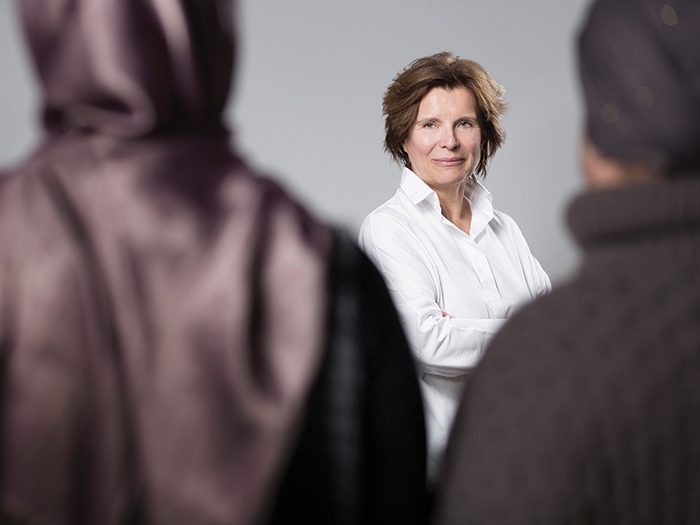
Luton, England, May 2016
“I couldn’t believe my son had gone to Syria. I didn’t know how to deal with it. I was angry inside—angry with those who had brainwashed him.” Khadijah Kamara, 37, is talking to a group of 40 mothers about 19-year-old Ibrahim, the eldest of her four teenage sons, who went to fight with extremists in Syria. He was killed in an air raid in September 2014.
The mothers, mostly of Bangladeshi, Pakistani and Somali origin, are beginning a free 10-week training program in a community center in the English town of Luton, close to London. The room is often used for keep-fit classes, but today’s lesson is altogether more serious.
It is a striking scene. Kamara, originally from Sierra Leone, her head and neck covered in a hijab, gazes out over a sea of colorful headscarves, saris and shalwar kameez.
She tells the women about her “loving and respectful boy”, who had wanted to become an engineer but was recruited to jihad. “My son has died and up to this day I cannot explain,” says Kamara.
The mothers listen intently. There are tears as Kamara says she discovered from another jihadi fighter that Ibrahim had been trying to contact her from Syria just before he died.
Sitting next to Kamara is Austrian sociologist Dr. Edit Schlaffer, who has flown in from Vienna to meet the mothers. Schlaffer is the creator of this ground-breaking program, called MotherSchools. Its purpose is simple and ambitious: to equip mothers to build their children’s resilience against recruitment by extremists, and to intervene when they recognize signs of radicalization.
Part of a global initiative, the course is being held in Luton for good reason. The town has frequently been linked to terrorism and has been dubbed a “hotbed of Islamist extremism” in the U.K. media.
Since November 2015 there have been seven major terrorist attacks in Britain, France, Belgium, Germany and Spain, claiming 329 lives and injuring 1,648. The perpetrators have often been home-grown jihadis, many inspired by Islamist propaganda and extremists on social media sites.
Over the ensuing weeks the Luton mothers will learn through role play and confidence-building exercises how to communicate better with their children, how to observe their psychological development, monitor their use of the Internet and recognize warning signs. The aim is to help the mothers develop resilience and build it in their children, families and communities.
Many of those in the room live in male-dominated households and rarely leave home beyond taking their children to school.
“Mothers have heard of radicalization,” says 74-year-old Bangladeshi-born Nazia Khanum, an expert on gender issues, forced marriage and community empowerment, who runs the MotherSchools course. “But they don’t know what it means. Tied to home, they feel isolated and terrified of the Internet. Edit helps them to end that isolation and to regain a connection with their children.”
Both she and Schlaffer have seen how terrorist recruiters continue to corrupt Europe’s alienated, jobless youth. More than 4,000 young Muslims have left Europe to fight in Syria and Iraq. “We have to bring sense into the world and we must start with our children,” says Schlaffer. “Mothers will make the world safe for us all.”
The Luton mothers will be among the first in Europe to graduate. She tells them: “You can be a new army—without weapons, but with words.”
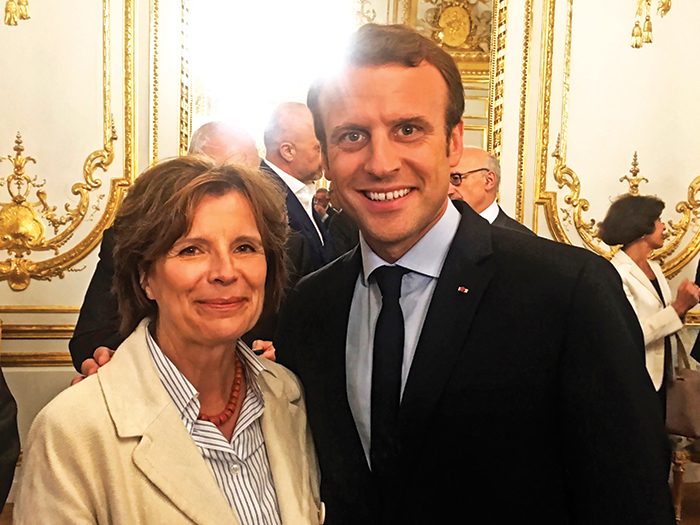
Crossing Continents
Schlaffer is the mother of two grown-up children and married to a professor of psychology. She is 67 but looks a decade younger, which is remarkable, given her punishing schedule.
In just one six-week period last autumn, for instance, she spent seven days visiting MotherSchools in Jordan, returned home to Vienna for two days before heading to Paris to speak at a global forum hosted by President Macron and flew on to Washington DC to speak at the American University. Days later she was spreading her message as a delegate at the 72nd Session of the UN General Assembly.
Her commitment reflects determination and strength. “Hope in these dark times and a sense of adventure and empowerment is what drives me on,” she says. “Why stay at home watching TV and feeling helpless?”
Schlaffer describes her childhood as “uneventful, peaceful and laid-back”, if not entirely conventional. Born in 1950 to middle-class professional parents, she spent the first six years of her life on her grandmother’s farm in eastern Austria, meters from Soviet-occupied Hungary.
“My friends and I would play under the eyes of a Russian soldier in his watchtower. My parents would tell me how lucky I was to be on this side of the fence.”
She discovered activism as a sociology student at Vienna University and had ambitions to become a foreign correspondent. But the offer of a research job led her towards a career as an academic. In the 1980s, as a sociology lecturer at the university, her research took her into the field.
She first worked with refugees—mainly traumatized women and children—from the Bosnian conflict. “I knew we were witnessing living history and I had to document it,” she says.
Her work in the 1990s would also take her to Pakistan, where she met women and children fleeing war in neighboring Afghanistan. There, she got to know a group of women who risked their lives to cross the lawless border into Pakistan, bringing out video evidence of fundamentalist brutality and executions.
“I have this vivid picture of their floating burqas as these brave women made their perilous journey,” she says.
The experience inspired her to launch Women without Borders (WwB) in 2001, with the goal of empowering women as agents of change. The NGO’s projects have included the first anti-extremist hotline in Yemen, empowerment strategies for girls in Rwanda and a women’s center in Afghanistan.
Then, in 2008, WwB launched SAVE, Sisters Against Violent Extremism, a female counter-terrorism platform that aims to unite women around the world. “We have to stand up for ourselves and for each other. Times of crisis are also times of opportunity,” says Schlaffer.
Khujand, Tajikistan, 2012
Four years later, Edit Schlaffer and a group of Tajik mothers are gathered in a sparsely furnished room at a small community center in Tajikistan’s second city. She is part of a mission, funded by the Organization for Security and Cooperation in Europe, to discuss increasing radicalization in the country. There is just a single small stove to ward off the mountain cold, but the shivering women are eager to talk.
“They were alarmed that their children were dropping out of school and being drawn to mosques funded by Saudi Arabia, where they were being taught an extremist interpretation of Islam. They felt powerless to intervene,” says Schlaffer.
“I said, ‘Can’t you talk to them?’ They replied that their sons were no longer boys, they were men—and that made it very difficult to challenge them. Some of these ‘men’ were just 12 years old, but they wanted to talk tough and be heroes. The women were trying to care for their children, but another influence had created a distance between them.”
Suddenly, Schlaffer had a lightbulb moment. “I can still see Rosaria, a mother of four in her mid-forties, in front of me. She had a wonderful smile. She said, ‘We mothers have to go back to school.’
“That was the moment that MotherSchools was born in my mind. I realized that it is mothers who are on the frontline against terror. We have to equip them with not only the confidence but also the right tools and techniques to interact better with their children.”
Schlaffer won funding to develop her ideas and a curriculum. She and her team researched exhaustively, interviewing a thousand mothers of adolescents in areas of historic conflict, including Northern Ireland, the Palestinian territories, Pakistan and Nigeria. Many of the mothers identified an urgent need for practical opportunities and skills to respond to the risk of radicalization.
The first MotherSchools pilot opened in Tajikistan in February 2013. Others followed in Austria, Belgium, Germany, Macedonia, the United Kingdom and several non-European countries.
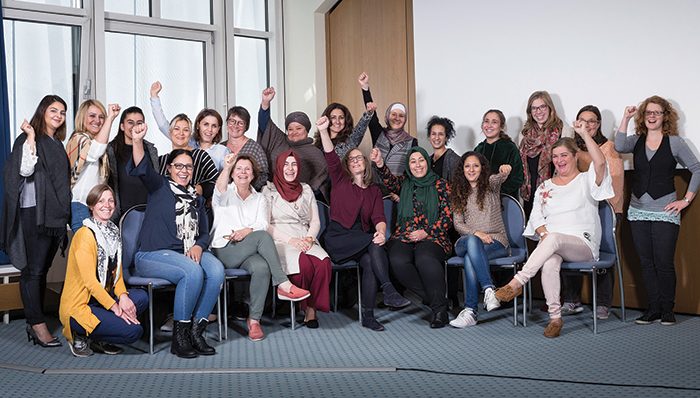
Würzburg, Bavaria, September 2017
Edit Schlaffer’s lightbulb idea is catching on fast. There are 22 women sitting in a circle as the sun filters through the windows at the Congress Centrum in Würzburg on the banks of the River Main. Famous for its baroque churches and vineyards, this peaceful corner of Germany seems a world away from Islamist terrorism.
Yet the previous year the country had suffered its first jihadist attack by an asylum seeker when a radicalized 17-year-old Afghan, armed with a knife and axe, attacked passengers on a train near the city.
The women, who hail from Turkey, Tunisia, Algeria and Syria, are social workers, teachers, translators, counselors and full-time mothers. They are about to be trained to launch and run MotherSchools in five separate locations in Bavaria.
The Bavarian government has asked Schlaffer to set up the schools as part of its radicalization prevention program. She may be a gifted enabler, but she knows it is only women from local communities who can effectively deliver the MotherSchools curriculum.
Schlaffer, wearing red sneakers and a flowing white shirt, starts proceedings with a challenge. “Each one of you is going to walk across the room,” she says.
There is reticence at first. It’s a daring test for the women, many of whom are used to playing a secondary role in their cultures. Then one young woman in jeans and black heels steps forward. She glides across the room. Her self-assertiveness inspires others to stand up. Soon the room is a colorful catwalk of elegant suits, jogging suits, sparkling trousers and headscarves. Cheers and laughter ring out.
This exercise leads to a discussion on how mothers send out signals to their children through their body language. “Children can read body language,” Schlaffer explains. “When we radiate self-confidence, so do they. Extremist recruiters are very warm and empathetic. They are also assertive, saying they will help young people to a better life. Mothers need to adopt those same approaches—but to a positive end. Making mothers strong starts with reinforcing the idea of how valuable they are, as mothers and as people.”
“If there is no prevention there is radicalization,” says Bouchra, a 46-year-old mother of five who will lead one of the Bavarian MotherSchools. “I came to learn. I want to do the right thing.”
Luton, September 2017
Back in the United Kingdom, 40-year-old Parveen is one of the latest graduates from the MotherSchools program in Luton. Born in Pakistan, she came to England 20 years ago. She has two teenage sons, aged 18 and 13.
“Before I did this course my eldest had stopped listening to me. I worried he was spending too much time on the computer,” she says. “The other mothers helped me re-learn how to talk to my children, how to avoid rows or silences. We have the computers downstairs in the sitting room and the family eats together rather than me being stuck in the kitchen.”
“I didn’t know what community meant,” she adds. “But now I have many friends and a part-time job as well. I feel as if I’m a mother bird who has learned to fly out into the wider world.”
Her words are clear evidence of the difference that MotherSchools can make in increasing mothers’ self-confidence and social connectedness so that they can better safeguard their children. As Edit Schlaffer says, “When I see the warmth and confidence in our graduates I know they can confront extremism and violence by changing attitudes.”
With additional reporting by Isabelle de Pommereau
Reader’s Digest European of the Year Our annual award recognizes an exclusive group of Europeans whose extraordinary work helps to make the world a better place. Edit Schlaffer is the 23rd winner of this unique Reader’s Digest award.
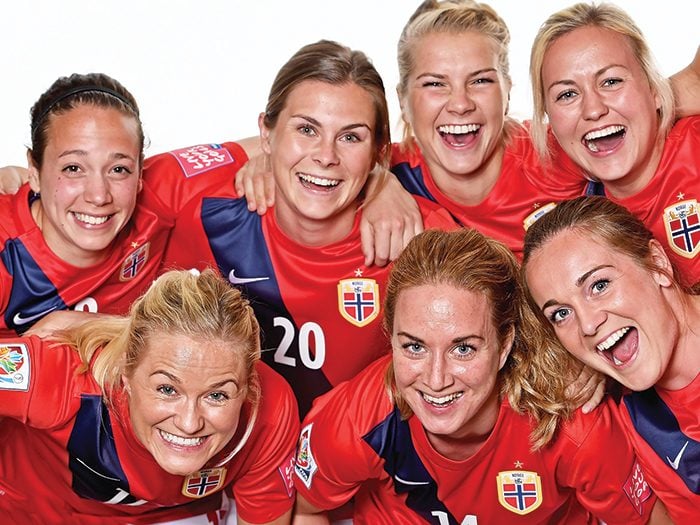
Norway Equalizes
Sport While some sports, such as tennis and athletics, usually reward international male and female competitors equally, others have been slow to address the gender pay gap. And nowhere is this more true than in football. Top male stars earn millions, while leading female players receive a relative pittance.
But the Norwegian Football Association wants to change that. It has agreed to pay all its international players the same amount—with the men even making a financial sacrifice to help the women’s team.
“Norway is a country where equal standing is very important for us, so I think it is good for the country and for the sport,” says players’ union chief Joachim Walltin. “It will certainly make a difference. Some of the women’s team (pictured above) have to hold down jobs as well as play football, and so then it’s hard to improve.”
Caroline Graham Hansen, a member of the women’s team, saluted her male counterparts: “Thank you for taking this step for female athletes, and for making it a bit easier to chase our dreams,” she said.
Chocolate Goes Pink
Food The romantically inclined celebrate Valentine’s Day in many countries on the 14th of this month, and roses and chocolates will be much in evidence. But what if the chocolates could match the color of the roses? In future, this could be possible, because a Swiss cocoa processing company, Barry Callebaut, has invented and plans to market pink chocolate.
The new product is made from a special ‘ruby’ bean grown in Ivory Coast, Ecuador and Brazil and is said to be the first new natural color since the introduction of white chocolate 80 years ago. But chocaholics will have to wait before they get their first fix—the new ruby chocolate won’t be available until later this year at the earliest.
A New View of Rome
Heritage The upper tiers of Rome’s Colosseum have been opened to tourists for the first time in 40 years, following a major restoration. The guided tours of the fourth and fifth levels of the amphitheater, originally the cheap seating for spectators watching gladiatorial contests, now offers superlative views over the Italian capital.
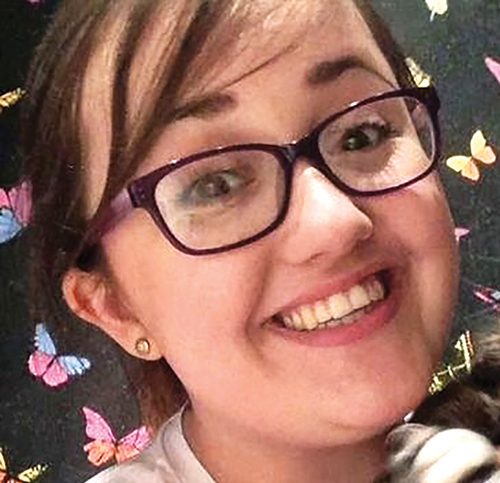
Nurse Saves Life at 30,000 feet
Heroes British nurse Emma Channing (pictured) was flying back to London after a holiday in Mexico when an announcement was made: “Are there any qualified doctors or nurses on board?”
Channing made herself known, and was taken to a passenger suffering from breathing difficulties. “You could tell immediately it was serious,” she says. “I have to admit to being a bit scared.”
But Channing’s nursing instincts took over. The man had suffered a broken rib on holiday and she realized he could be suffering from potentially fatal sepsis. She told the pilot they needed to land, and the plane diverted to Newfoundland, Canada, where paramedics were waiting on the runway to treat the man.
“You never expect something like that to happen to you on holiday,” says Channing. “You just do everything you can.”
Sources: Sport, The Guardian, 7.10.17. Food, The Local (Switzerland), 7.9.17. Heritage, The Local (Italy), 3.10.17. Heroes, Liverpool Echo, 20.9.17